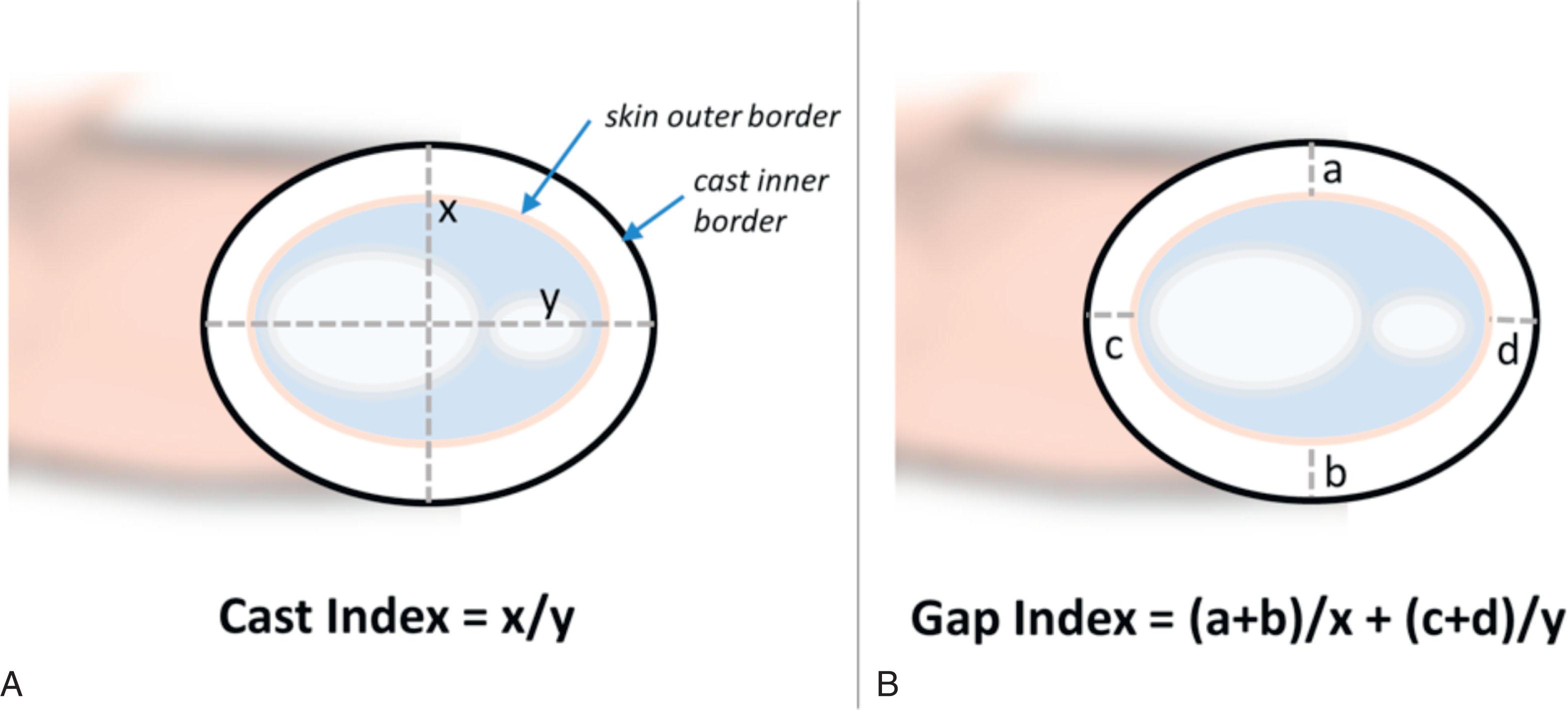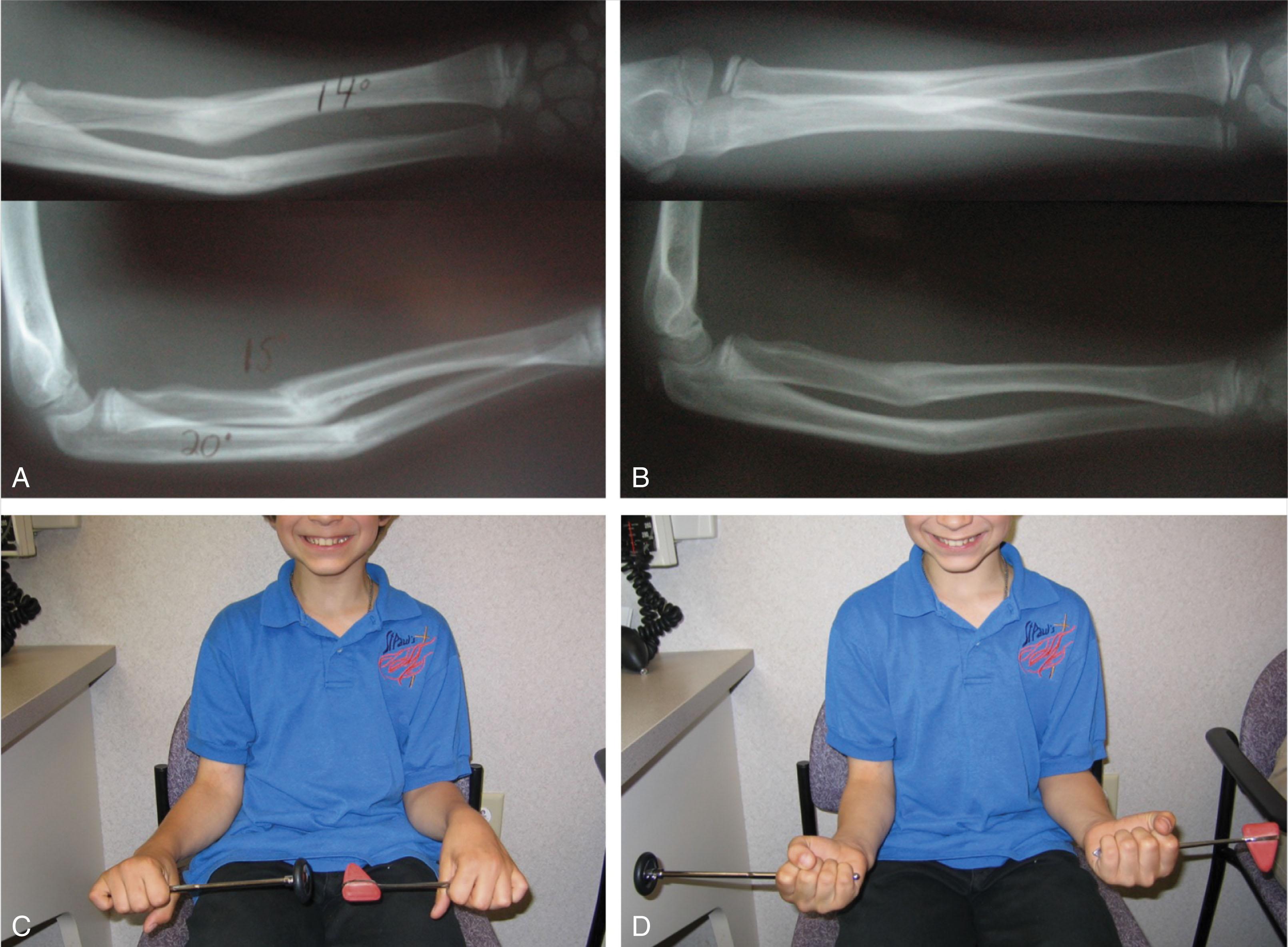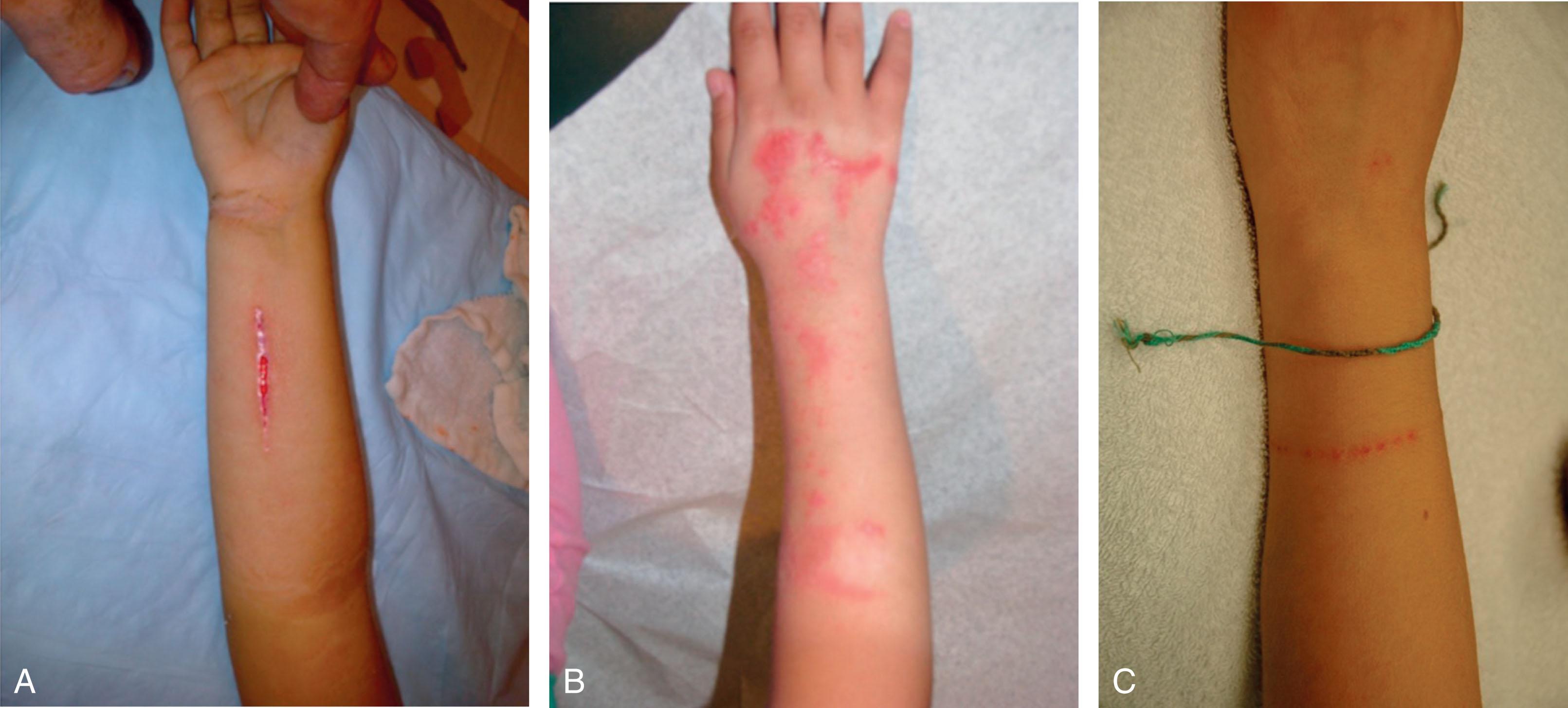Physical Address
304 North Cardinal St.
Dorchester Center, MA 02124
Pediatric forearm fractures account for 6% to 18% of all pediatric fractures. Much debate exists regarding the most appropriate management of these injuries. Although a number of “acceptable” angulation and displacement parameters for pediatric forearm fractures have been proposed, there is no universally agreed-upon set of criteria for acceptable deformity subsequent remodeling potential. Some authors have even questioned the need for a formal reduction at all. The level of the fracture, fracture pattern, mechanism of injury, involved bone(s), degree of displacement or angulation, loss of radial bow, and patient age and gender can all have an effect on the potential for a fracture to successfully remodel. Furthermore, treatment choice has been shown to vary based on geography, insurance status, and whether or not the patient is admitted to a children’s hospital. Thus, a number of considerations, including the risk of complications, must be considered by the treating provider.
Consistent with other studies evaluating pediatric fractures, boys are much more prone to forearm fractures than girls. The age distribution of these fractures is slightly bimodal, with grade-school and adolescent populations being most affected. Children are more apt to sustain forearm fractures during falls, whereas sports is the primary contributor in adolescents and young adults. Seasonal variations also have been described, with forearm fractures occurring more often in warmer months.
Pediatric forearm fractures are often grouped by fracture location, as the deforming muscular forces will influence the necessary reduction maneuver and cast mold. Specific to location, pediatric forearm fractures have a predilection for the metaphysis, followed by the diaphysis, and then the epiphysis. Fractures of the distal radius account for the majority of fractures in the pediatric forearm. Fracture location also has implications on choice of management: the distal radial physis accounts for 75% of total growth, whereas the distal ulnar physis is responsible for 80% of total growth. This results in excellent remodeling potential for distal fractures, with less deformity tolerated in more proximal fractures. The scope of this chapter will primarily focus on complications of diaphyseal pediatric forearm fractures, as fractures of the distal radius are covered in the next chapter.
Numerous studies have suggested that over 90% of all unstable pediatric forearm fractures can be successfully managed nonoperatively ( Table 5.1 ), and multiple reduction guidelines have been suggested. Although no standard guidelines exist, the parameters set forth by Noonan and Price provide a rough framework ( Table 5.2 ). When assessing acceptable alignment of these fractures, it is important to assess all planes including rotation. Careful attention should be paid to restoration of the radial bow. On the anteroposterior (AP) radiograph, the bicipital tuberosity should be 180 degrees from the radial styloid. Conversely, on the lateral radiograph, the ulnar styloid should be 180 degrees from the coronoid process. Diaphyseal fractures, especially more proximal fractures, cannot be treated with nonoperative management, nor can distal or metaphyseal-type fractures. This is due both to the greater effect these types of fractures have on range of motion and deformity as well as their poorer remodeling potential. Furthermore, adolescent patients have less remodeling potential, and, thus, closed reduction with casting may not be effective. Children older than 10 years have a nearly 2.8 times increased odds of nonoperative management failure. One study suggested good outcomes after nonoperative management in patients with at least 4 years of remaining growth. Regardless, nonoperative management remains an important first-line treatment for many (if not most) pediatric forearm fractures. Although often considered the “less invasive” management option, nonoperative management of pediatric forearm fractures is not without complications.
| Study | Success Rate |
|---|---|
| Thomas et al. 1975 | 93% |
| Daruwalla 1979 | 97% |
| Creasman et al. 1984 | 95% |
| Price et al. 1990 | 92% |
| Zionts et al. 2005 | 88% |
| Tarmuzi et al. 2009 | 97% |
| Patient Age | Angulation | Rotation | Bayonet Apposition |
|---|---|---|---|
| 0–9 years (0–8 girls, 0–10 boys) | <15 degrees | <45° | ≤1 cm |
| >9 years (>8 girls, >10 boys) | <10 degrees proximal/midshaft | <30° | ≤1 cm |
| >9 years (>8 girls, >10 boys) | <15 degrees distal | <30° | ≤1 cm |
When reduction is performed, loss of reduction has been shown to occur in 7% to 32% of pediatric forearm fractures. Higher-powered retrospective and multicenter prospective trials have suggested a loss of reduction rate closer to 30%. Loss of reduction might be considered an anticipated potential sequela of nonoperative management rather than an overt complication and often is managed with rereduction. One recent study reported successful rereduction of pediatric forearm shaft fractures at an average of 15 days (range 4–35 days) after injury, with the average cost for rereduction amounting to less than half that of surgical stabilization.
Regarding loss of reduction, diaphyseal pediatric forearm fractures tend to behave unpredictably, with a number of studies showing both patient- and clinician-specific risk factors for loss of reduction. A retrospective review of 57 patients found poor reduction and complete fractures to be predictive of displacement. A prospective study of 76 consecutive patients found a modified three-point index to be the only significant predictor of displacement. An even larger prospective study of 246 consecutive patients found hand dominance and fracture severity to be the main clinical predictors of loss of reduction. Furthermore, a comprehensive radiographic retrospective review of 282 patients found age 10 years or older, proximal radius fractures, and initial ulnar angulation of less than 15 degrees to be the best predictors of loss of reduction, with over half of patients having loss of reduction in the first week and 95% failing within 3 weeks. These studies emphasize the importance of improving indications for closed treatment and ensuring quality casting and molding when treating these fractures nonoperatively.
Some debate exists as to the type of immobilization used for pediatric forearm fractures. Long arm cast placement is considered the standard for most forearm fractures. Long arm casts provide the theoretical advantages of immobilizing the elbow and controlling rotation better. Both extended and flexed casts have been shown to be efficacious. Hand position within the cast does not appear to affect loss of reduction rates. It also has been suggested that sugar-tong splints can effectively serve as initial immobilization in pediatric forearm fractures. Furthermore, more distal fractures (particularly the distal one-third) can be immobilized in a short arm cast. When using a short arm cast, care should be taken to evaluate the cast index . First described in 1994, the cast index ( Fig. 5.1 ) estimates the cast mold by dividing the width of the inner border of the cast on the lateral radiograph from the width on the AP radiograph. A cast index of less than 0.8 has been associated with decreased loss of reduction rates. A number of other indices to assess reduction in forearm fractures have been suggested, including the gap index, the padding index, the three-point index, the Canterbury index, and the second metacarpal-radius angle. Of these, the gap index (a measurement that assesses both the amount of padding as well as the cast mold, Fig. 5.1 ) seems to correlate best with the cast index and may provide increased sensitivity for fracture displacement. Although the optimal measurement index for a well-molded cast might be debated, such efforts highlight the importance of instructing practitioners on the importance of appropriate immobilization choice and well-molded casts or splints to decrease loss of reduction.

Refracture of pediatric forearm fractures treated with closed reduction and casting has been noted to occur in 1.4% to 8% of all cases. This usually occurs in the setting of repeat trauma such as a fall onto the affected arm. It has been noted to occur mostly within the first year after injury. One study compared 63 refractures with historic case-matched controls and found an average time to refracture of 10 months. Proximal and middle-third fractures were much more likely to refracture, with fracture location being an independent risk factor. Notably, careful scrutiny of radiographs may help determine the length of immobilization necessary, as 48% of patients sustaining a refracture had fracture lines visible on their latest radiographs. Extended functional bracing initially demonstrated some potential to lower refracture rates. However, a recent larger retrospective review, comparing casting alone with casting followed by extended functional bracing, did not discern a difference in refracture rate between groups.
Residual angulation is the most obvious source of loss of motion, but the presence of a malunion may not directly correlate with clinical function ( Fig. 5.2 ). A retrospective review of 39 patients with malunited nonoperatively managed pediatric forearm fractures found that 92% of patients had good or excellent outcomes, with many patients demonstrating compensation and/or complete unawareness of their deficits. Another study of 29 older children and adolescents found the maximum radial angulation on either the AP or lateral radiograph correlated with loss of motion. In patients with persistently symptomatic loss of motion, osteotomy can be performed with a reasonable likelihood of improving motion; one small series demonstrated an average improvement of 102 degrees of forearm motion. Another series of 17 patients demonstrated more modest gains in range of motion but suggested that the discrepancy could be because all of their patients were older than 10 years and were treated with osteotomy more than 1 year from injury. They also found good results with concomitant release of the interosseous membrane, which consequently did not result in any significant weakness or instability.

As seen in the previous section, stiffness and loss of motion are known sequelae of pediatric forearm fractures. Stiffness can be caused by a number of factors, including bony malalignment, joint contractures, heterotopic ossification, and scarring or tensioning of the interosseous membrane. An arc of pronation or supination of 50 degrees in each direction has been shown to be sufficient for most pediatric tasks. Further investigation has sought to better characterize objective deficits after pediatric forearm fractures. One prospective study followed hand function in 26 children between the ages of 3 and 13 years who sustained forearm fractures and underwent in situ casting without formal reduction. These patients exhibited initial loss of grip strength, supination, and pronation at 6 months after injury. However, by 1 year the affected side was comparable to the unaffected side. Another study involved long-term follow-up (mean 11 years after injury) of pediatric patients who underwent nonoperative management of forearm fractures. No difference was found in grip strength when compared to age-matched non-injured controls. Interestingly, previously injured patients demonstrated slightly greater rotatory range of motion than uninjured controls. Hand function was investigated by another group that performed a 6-month postinjury evaluation of grip, key pinch, and chuck grip strength in 97 patients between the ages of 4 and 18 years who underwent a variety of treatments for pediatric forearm fractures. They found that the only associated difference between strength measures and expected values was the presence of a complication or redisplacement of the fracture.
Neurapraxia, or temporary loss of motor and/or sensory function secondary to blockage of nerve conduction, is an uncommon complication after treatment of pediatric both bone forearm fractures. Neurapraxia has rarely been described after nonoperative management and usually is caused by temporary compression from edema that resolves over time. Other sources of nerve injury have been described, including bony entrapment at the fracture site, callus entrapment, laceration at the fracture site, and compartment syndrome. In these cases, surgical exploration may be considered to assess the continuity of the nerve and treat the pathology. In patients in whom the cause of nerve dysfunction is in question (and compartment syndrome has been ruled out), advanced imaging, such as ultrasound or magnetic resonance imaging, can be used to examine the suspected injured nerve. Nerve conduction studies also may help to localize the level of injury. The median nerve is the most frequently documented nerve injury in pediatric forearm fractures, but ulnar nerve involvement also has been described. Thus, it is imperative that the treating clinician obtains a thorough neurovascular examination when first seeing the patient.
Although the prevalence of cast-related complications is not well reported in the literature, most practitioners who apply casts are familiar with the perils involved. Pediatric orthopedists have been shown to lose cast-related malpractice claims 35% of the time, with an average indemnity payment of US$101,568 per successful claim. Cast-related complications vary widely, including skin breakdown ( Fig. 5.3 ), compartment syndrome, severe soft-tissue loss, joint contracture, and nerve palsy.

A particularly common injury related to cast application is a thermal burn. Burns are the result of a number of cast-related variables, including cast material, cast thickness, dip-water temperature, and curing environment. One center evaluated a small series of pediatric patients and found an incidence of 4.3% for cast saw burns, with a treatment/indemnity ranging from US$2,995 to US$25,000 per case.
Another concern with cast application involves cast-induced pressure. This can result in pressure sores and, in severe cases, compartment syndrome. This is exacerbated by postinjury swelling. Cast-induced pressure has been shown to be dependent upon casting technique as well as the type of valve applied to the cast. These issues highlight the importance of attention to detail when applying casts, as well as the need to properly educate patients and families on cast care, close follow-up, and the possibility of complications.
First described by Volkman in 1881, compartment syndrome is a rare but devastating consequence of limb injuries. This occurs when interstitial pressure within a fascial compartment exceeds the perfusion gradient across capillary beds, resulting in circulatory compromise and tissue ischemia. Left untreated, compartment syndrome can result in severe tissue loss, amputation, or even death. Pediatric patients may present with different symptoms than adults regarding compartment syndrome. It has been suggested that, in addition to potential classic signs of compartment syndrome, children may present with the three As – a nxiety, a gitation, and increasing a nalgesic requirements.
Compartment syndrome of the forearm can result from trauma, cast constriction, infection, reperfusion injury, or iatrogenic injury. A retrospective review of 131 cases of pediatric acute compartment syndrome identified 27 cases involving the upper extremity, with 80% of the patients being male with an average age of 12 years. Some 74% of upper extremity cases were related to forearm fracture, resulting in an overall compartment syndrome risk of 1.04%. Notably, the presence of an open fracture was an independent risk factor for compartment syndrome (relative risk = 2.2).
Treatment of compartment syndrome consists of prompt diagnosis and fasciotomy. When present, management within 6 hours of onset may portend a better prognosis, although excellent recovery has even been seen in the pediatric upper extremity over 48 hours from onset. Thus, practitioners must remain vigilant of the potential for compartment syndrome in pediatric fractures.
A thorough clinical examination and radiographic workup are warranted for all suspected cases of pediatric forearm fractures. This includes a detailed neurovascular examination as well as radiographs of “a joint above and below” the site of injury. Wrist and elbow radiographs are especially relevant to the evaluation of pediatric forearm fractures because concomitant injuries are frequently present and can change the anticipated prognosis.
A pediatric forearm fracture with an ipsilateral supracondylar humeral fracture is termed a “floating elbow.” The presence of both of these injuries together is an indicator of higher energy trauma. Floating elbow occurs in less than 5% of supracondylar humeral fractures; however, these injuries have been flagged for their potential higher risk of compartment syndrome. A recent highly powered retrospective review refuted the findings of increased rates of compartment syndrome in floating elbows, but an association with delay in management was found, suggesting that these injuries be treated emergently. Clinicians also should recognize these injuries for logistical reasons, because attempts to reduce one fracture risk worsening the other, and surgeons may be more inclined to treat both fractures operatively.
A Monteggia lesion represents a fracture of the ulna with an associated disruption of the radiocapitellar joint. These injuries represent less than 1% of all pediatric forearm fractures, with an annual incidence of 1:100,000. Although Monteggia lesions themselves are fairly rare, they are missed on initial presentation 16% to 60% of the time. Careful scrutiny of the elbow radiographs can help to diagnose these injuries. These injuries occasionally may be successfully treated with closed reduction, although surgical management is often required. Failure to recognize and appropriately treat these injuries can have devastating consequences for the patient, with severe loss of range of motion and late osteoarthritis.
A Galeazzi lesion represents the counterpart to the Monteggia lesion, presenting as a (usually distal third) radius fracture with an associated distal radioulnar joint subluxation or dislocation. These injuries occur in 0.3% to 2.8% of all pediatric forearm fractures, although one retrospective series of 198 displaced forearm fractures found that they may be underdiagnosed, with the series identifying 13% of displaced fractures as having a Galeazzi lesion. In contrast to Monteggia lesions, Galeazzi lesions often are treated with closed reduction.
Become a Clinical Tree membership for Full access and enjoy Unlimited articles
If you are a member. Log in here